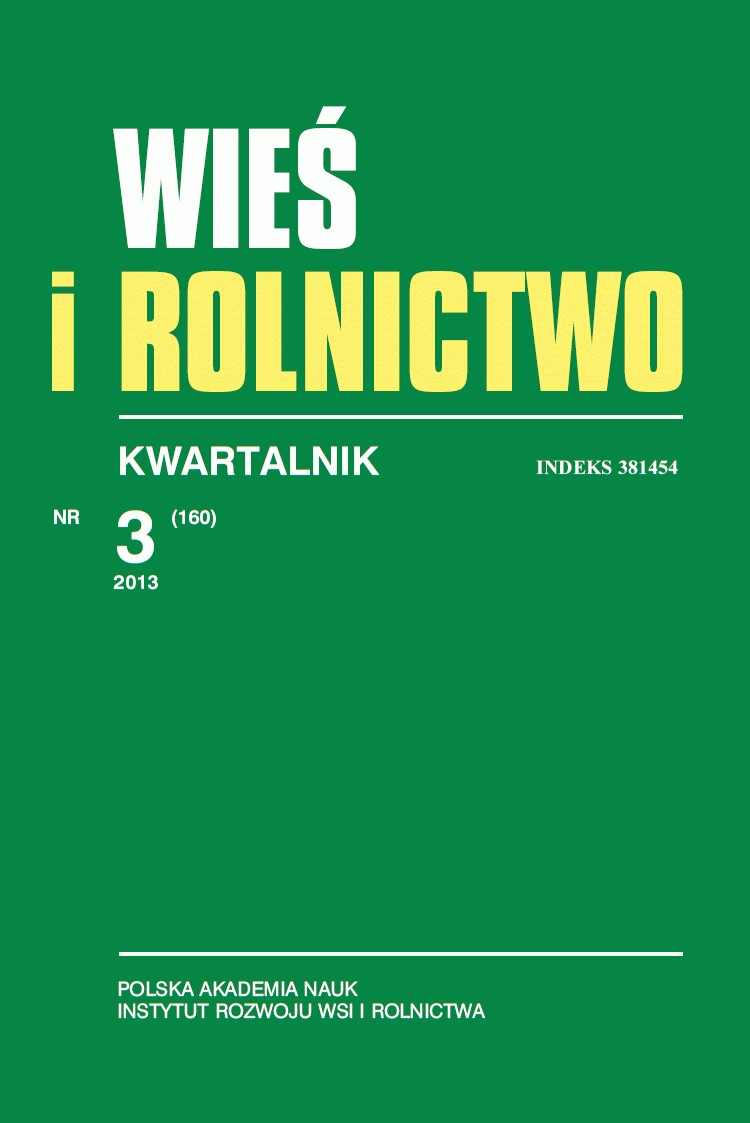Testing for socio-economic characteristics in areas with less characteristics of an agricultural development function
DOI:
https://doi.org/10.53098/wir.2013.3.160/04Keywords:
rural development, problem agricultural areas, deagrarization of local economyAbstract
The article is based on studies conducted by IUNG (Instytut Uprawy Nawożenia i Gleboznawstwa – Institute of Soil Science and Plant Cultivation) on the subject of delimiting problem areas in agriculture, as well as on studies published by IRWiR PAN (Instytut Rozwoju Wsi i Rolnictwa Polskiej Akademii Nauk – Institute of Rural and Agricultural Development of the Polish Academy of Sciences) focusing on the spatial differentiation of rural areas with regard to socio-economic development. The analyses of IUNG are based on agro-technical terminology, while those of IRWiR PAN employ socio-economic terms. An analysis of the results of both sets of studies indicates that some areas considered problematic for agriculture are less advanced with regard to the level of socio-economic development and the dynamics of transformations. However, this is the case mainly in the lowlands – in the highland and sub-mountain regions most problem areas in agriculture typically present a relatively high degree and dynamics of socio-economic development. In these areas the agricultural economic function is undergoing gradual reduction in favour of other functions, including tourism and recreation. In problem areas in agriculture situated in the lowlands, such processes of deagrarianization of economic structures are relatively less advanced to a large degree. This currently leads to a decline in population of some of these areas, as well as to other unfavourable phenomena typical of depopulation in some of them. The current instruments of cohesion and agricultural policy (including income redistribution towards agriculture in less favoured areas) cannot counteract the spatial stratification processes in rural areas.References
Czudec A., 2013: Rolnictwo na obszarach górskich – kierunki dywersyfikacji działalności. „Polish Journal of Agronomii” (w druku).
Jadczyszyn J., 2009: Regionalne zróżnicowanie obszarów problemowych rolnictwa (OPR) w Polsce. Instrukcja upowszechnieniowa Nr 163. IUNG-PIB, Puławy.
Jadczyszyn J., Filipiak K., Stuczyński T., 2008: Ocena przestrzennego rozmieszczenia gleb podlegających skrajnej marginalizacji na obszarach ONW w Polsce. „Studia i Raporty IUNG-PIB” 12: 191-201.
Jadczyszyn J., Filipiak K., Stuczyński T., Koza P., Wilkos S., 2010: Obszary problemowe rolnictwa (OPR) i obszary o niekorzystnych warunkach gospodarowania w Polsce – różnice kryteriów i zasięgów przestrzennych. „Studia i Raporty IUNG-PIB” 21: 9-20.
Musiał W., 2008: Obszary problemowe rolnictwa w terenach górzystych Europy. „Studia i Raporty IUNG-PIB” 12: 81-92.
Rosner A., 2012: Zmiany rozkładu przestrzennego zaludnienia obszarów wiejskich. Wiejskie obszary zmniejszające zaludnienie i koncentrujące ludność wiejską. IRWiR PAN, Warszawa.
Stuczyński T., Filipiak K., Kozyra J., Górski T., Jadczyszyn J., 2006: Obszary o niekorzystnych warunkach gospodarowania w Polsce. IUNG-PIB, Puławy.
Zróżnicowanie poziomu rozwoju społeczno-gospodarczego obszarów wiejskich a zróżnicowanie dynamiki przemian, 2007. Red. A. Rosner. IRWiR PAN, Warszawa.
Downloads
Article file downloads
Pages
How to Cite
Issue
Section
License
Copyright (c) 2013 Wieś i Rolnictwo

This work is licensed under a Creative Commons Attribution 4.0 International License.






